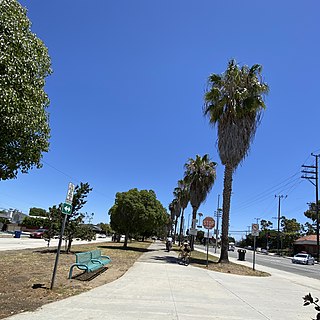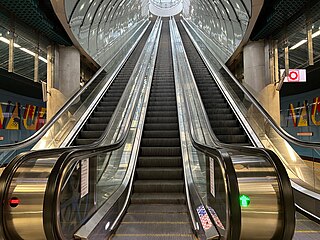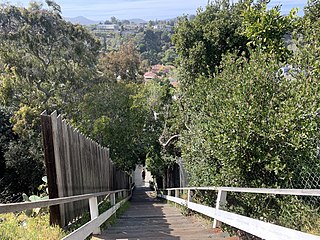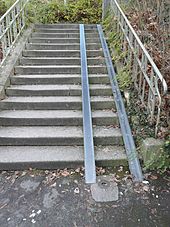
A curb cut (U.S.), curb ramp, depressed curb,dropped kerb (UK), pram ramp, or kerb ramp (Australia) is a solid ramp graded down from the top surface of a sidewalk to the surface of an adjoining street. It is designed primarily for pedestrian usage and commonly found in urban areas where pedestrian activity is expected. In comparison with a conventional curb a curb cut is finished at an intermediate gradient that connects both surfaces, sometimes with tactile paving.

A skatepark, or skate park, is a purpose-built recreational environment made for skateboarding, BMX, scootering, and aggressive inline skating. A skatepark may contain half-pipes, handrails, funboxes, vert ramps, stairsets, quarter pipes, ledges, spine transfers, pyramids, banked ramps, full pipes, pools, bowls, snake runs, and any number of other objects.

Stairs are a structure designed to bridge a large vertical distance between lower and higher levels by dividing it into smaller vertical distances. This is achieved as a diagonal series of horizontal platforms called steps which enable passage to the other level by stepping from one to another step in turn. Steps are very typically rectangular. Stairs may be straight, round, or may consist of two or more straight pieces connected at angles.

A stairwell or stair room is a room in a building where a stair is located, and is used to connect walkways between floors so that one can move in height. Collectively, a set of stairs and a stairwell is referred to as a staircase or stairway. In buildings with several housing units, a stairway can be a necessary common area for getting to and from apartments.

A racing bicycle, also known as a road bike is a bicycle designed for competitive road cycling, a sport governed by and according to the rules of the Union Cycliste Internationale (UCI).

A hand truck, also known as a hand trolley, dolly, stack truck, trundler, box cart, sack barrow, cart, sack truck, two wheeler, or bag barrow, is an L-shaped box-moving handcart with handles at one end, wheels at the base, with a small ledge to set objects on, flat against the floor when the hand-truck is upright. The objects to be moved are tilted forward, the ledge is inserted underneath them, and the objects allowed to tilt back and rest on the ledge. The truck and objects are then tilted backward until the weight is balanced over the wheels, making otherwise bulky and heavy objects easier to move. It is a first-class lever.

A handrail is a rail that is designed to be grasped by the hand so as to provide safety or support. In Britain, handrails are referred to as banisters. Handrails are commonly used while ascending or descending stairways and escalators in order to prevent injurious falls, and to provide bodily support in bathrooms or similar areas. Handrails are typically supported by balusters or attached to walls.

Guard rails, guardrails, railings or protective guarding, in general, are a boundary feature and may be a means to prevent or deter access to dangerous or off-limits areas while allowing light and visibility in a greater way than a fence. Common shapes are flat, rounded edge, and tubular in horizontal railings, whereas tetraform spear-headed or ball-finialled are most common in vertical railings around homes. Park and garden railings commonly in metalworking feature swirls, leaves, plate metal areas and/or motifs particularly on and beside gates.

A curb, or kerb, is the edge where a raised sidewalk or road median/central reservation meets a street or other roadway.

A subway, also known as an underpass, is a grade-separated pedestrian crossing which crosses underneath a road or railway in order to entirely separate pedestrians and cyclists from motor traffic or trains respectively.
A lacrosse stick or crosse is used to play the sport of lacrosse. Players use the lacrosse stick to handle the ball and to strike or "check" opposing players' sticks, causing them to drop the ball. The head of a lacrosse stick is roughly triangular in shape and is strung with loose netting that allows the ball to be caught, carried, passed, or shot.

Tactile paving is a system of textured ground surface indicators found at roadsides, by and on stairs, and on railway station platforms, to assist pedestrians who are vision impaired.

The Culver Boulevard Median Bike Path is Class I rail trail bicycle path, walk route and linear park on Culver Boulevard in western Los Angeles County, California.

The Main Yarra Trail, also known as the Yarra Trail is a shared-use path for cyclists and pedestrians, which follows the Yarra River through the northeastern suburbs of Melbourne, Victoria, Australia.

The Gibbs Street Pedestrian Bridge, more formally known as the US Congresswoman Darlene Hooley Pedestrian Bridge at Gibbs Street, is an approximately 700-foot (210 m) pedestrian bridge in Portland, Oregon, United States, which opened on July 14, 2012. It connects the Lair Hill neighborhood with the South Waterfront area. It is a steel box girder bridge, a change from the original plans for an extradosed bridge, made to reduce the project's cost.

An escalator is a moving staircase which carries people between floors of a building or structure. It consists of a motor-driven chain of individually linked steps on a track which cycle on a pair of tracks which keep the step tread horizontal.

Bicycle lifts are powered mechanical systems for moving bicycles uphill. They are used where the steepness of a slope or other situations like subway crowds make riding uphill difficult.

The Los Angeles River bicycle path is a Class I bicycle and pedestrian path in the Greater Los Angeles area running from north to east along the Los Angeles River through Griffith Park in an area known as the Glendale Narrows. The 7.4 mile section of bikeway through the Glendale Narrows is known as the Elysian Valley Bicycle & Pedestrian Path. The bike path also runs from the city of Vernon to Long Beach, California. This section is referred to as LARIO, or more formally, the Los Angeles River Bikeway.

The "Santa Monica Stairs" refer primarily to a pair of outdoor stairways in California descending to the northwest from Adelaide Drive in Santa Monica, to Santa Monica Canyon in Los Angeles.

The James D. Pfluger Pedestrian and Bicycle Bridge is a shared use bridge for pedestrians and cyclists spanning Lady Bird Lake in downtown Austin, Texas. Opened in 2001, the bridge connects the north and south sides of the Ann and Roy Butler Hike-and-Bike Trail and features an unusual "double curve" design. The bridge runs parallel to the Lamar Boulevard Bridge, which carries road traffic across the lake roughly 200 feet (61 m) to the west.






















